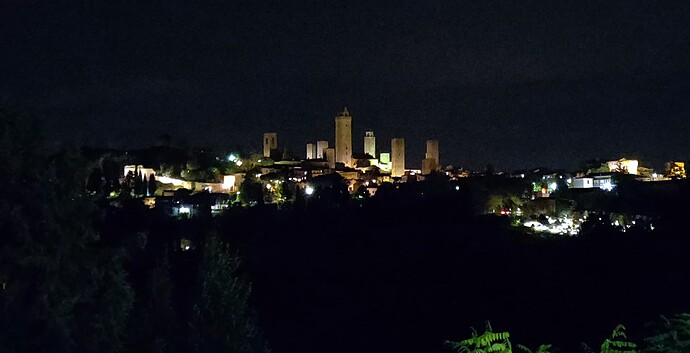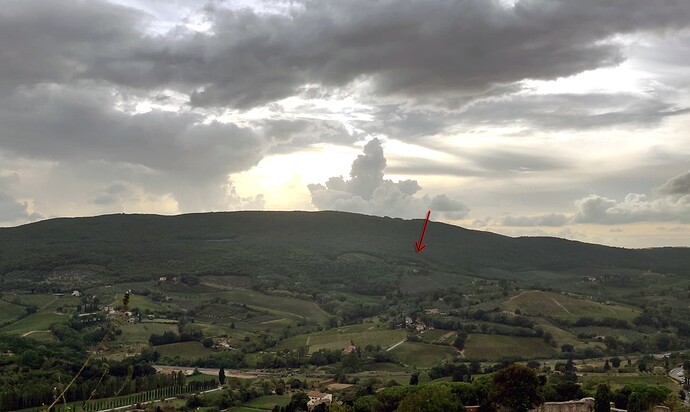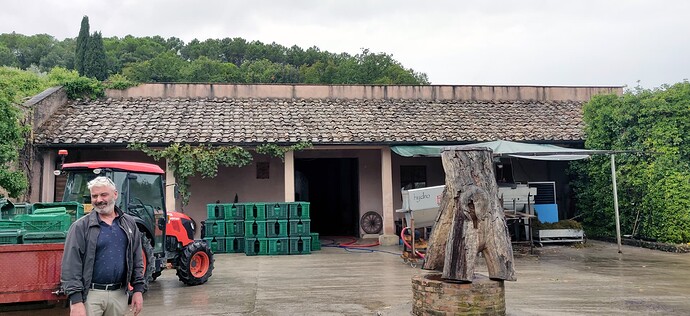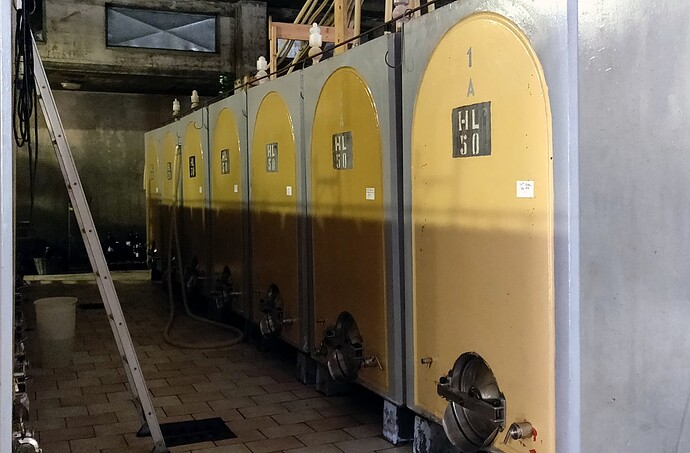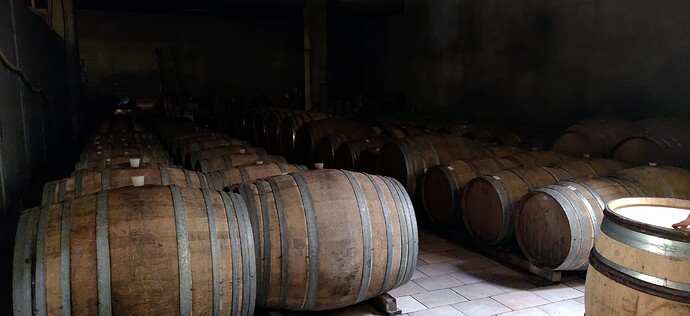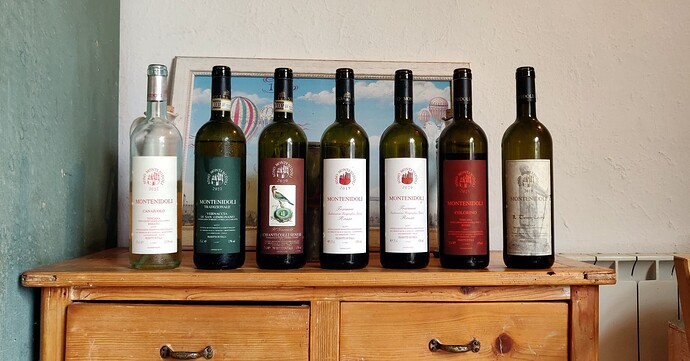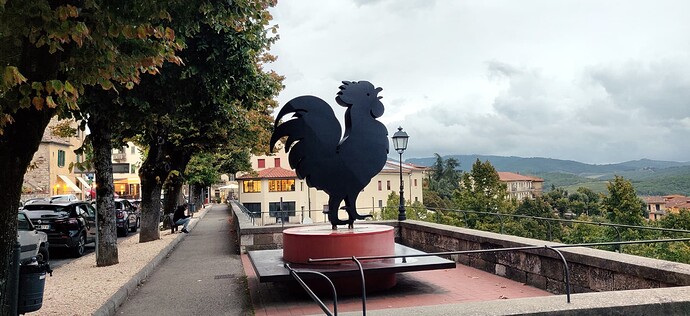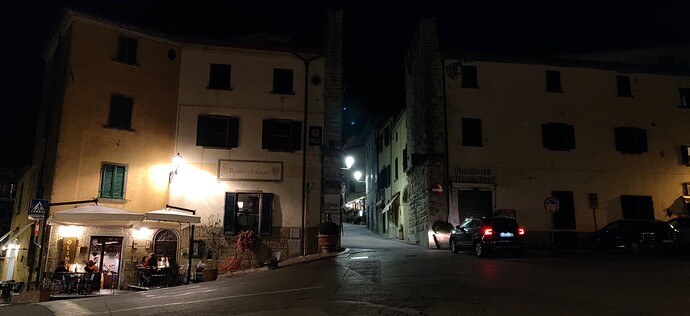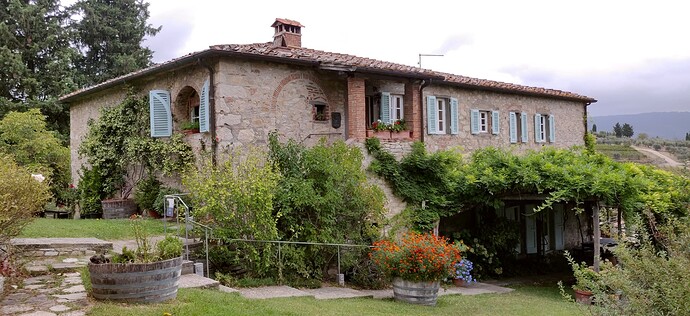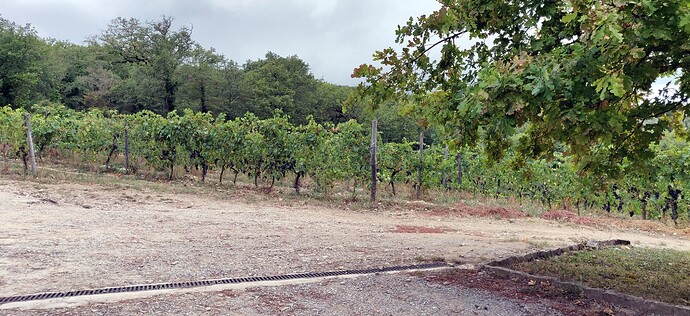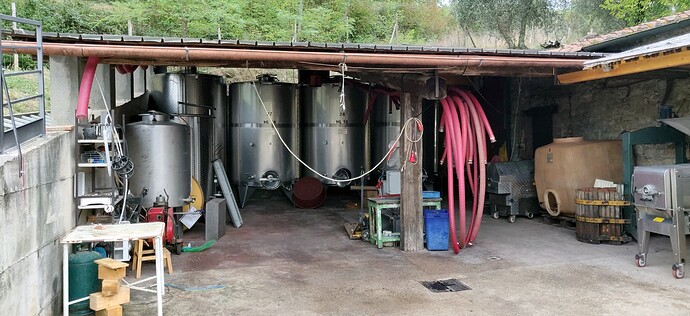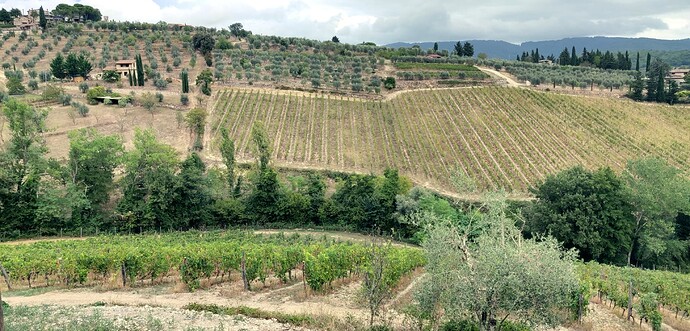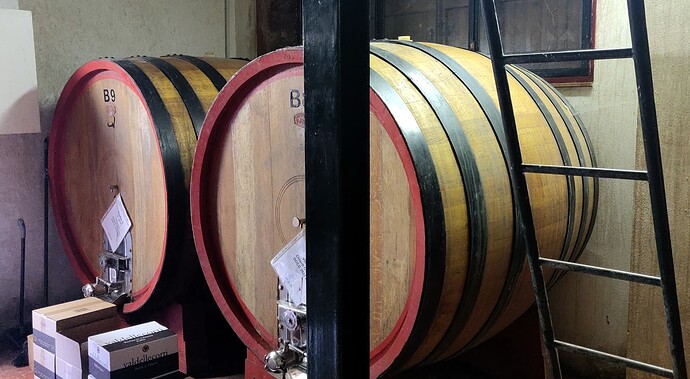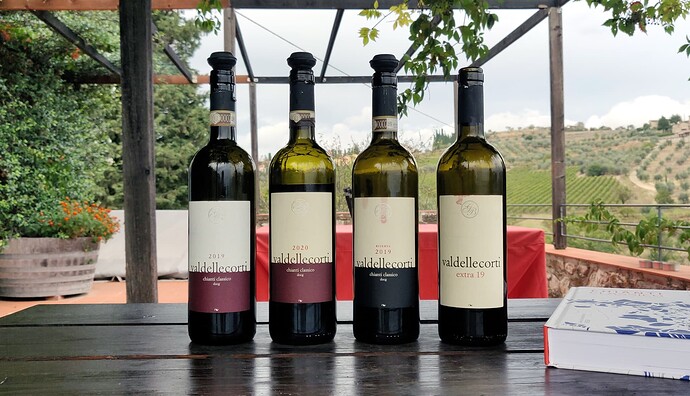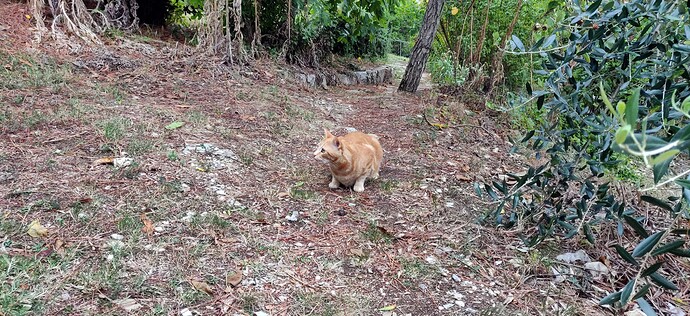I visited Tuscany with my SO in late September. It was supposed to be a nice holiday week around the Tuscan countryside, but I must say that even though the trip itself was fantastic, both getting there and back were anything but nice.
The return flights (a quick 6-hour return changed into a massive 23-hour sh*tshow during which we managed to see five different airports) was a miserable adventure worth a thread alone, but even the flights to Italy were pretty horrible to begin with! The day I left for Tuscany there was an unannounced staff strike at the Helsinki airport, which meant I departed with a delay of more than an hour and without my checked luggage - although I learned of the this latter matter only after I had arrived to the Florence airport, when my luggage failed to appear.
Thanks to the delay I almost missed my connecting flight from Frankfurt to Florence - I had to jog an almost 2-kilometer (1 mile) stretch from one huge terminal to another in Frankfurt, just barely making it to the airplane. It seemed there were many Italian people on the first flight, but a lot of empty seats in the second one, so it’s possible all those people didn’t make it in time to the gate and thus were left behind…
Anyways, after spending a night in Florence, me and my SO travelled to Siena, where we stayed for one night, sightseeing the wonderful city. The next day we rented a car from Siena and drove to San Gimigano - visiting Monteriggioni and Poggibonsi on the way - and spent the evening checking out the historical town, its churches, museums and Torre Grossa, the tallest of San Gimignano’s many towers.
San Gimignano by night:
We had booked a visit to Montenidoli - the traditionalist maverick of San Gimignano - for the next morning. Little did we know that the road suggested by Google Maps was a nonexistent one, first guiding us to some random vineyards, then telling us to drive through a thick forest. At that point I turned our car around, drove the hell out from the vineyard we had no business being in and called the people at Montenidoli that we are going to be late from our scheduled meeting - we’re nearby, but there is no direct road to take us there, so we had to drive back to San Gimignano and take another road to the winery.
Finally, after driving a long stretch on narrow, wildly winding and seemingly unending dirt roads, we finally arrived at Montenidoli, some 20 minutes late.
Montenidoli
The history of this estate goes a long way back, but its history as we know it begins in 1965, when Elisabetta Fagiuoli and her partner, Sergio Muratori, discovered the Montenidoli estate and purchased it with the help of Elisabetta’s grandmother. Back then, San Gimignano and the whole Tuscan countryside was nothing more than backwater country as people had left en masse to look for work in the big cities, abandoning many old estates.
The historical Montenidoli (“mountain of bird nests”) estate was - and still is - very large. The whole estate covers more than 200 hectares on the east-facing mountainside, just a few kilometers west from San Gimignano and easily identifiable from the town. However, of those 200-and-some hectares, only 23 ha are under vine. There are also 10 ha of olive groves, but the rest of the estate (+180 ha) is just untouched forest, which surrounds the winery and the vineyards on the hillside, serving as means to control some of the temperature (as the air in the forest stays cool during the hot, sunny days, then spreads the cool air out, over the vineyards, during the night), protect from the wind and also offer habitat for the local fauna and flora. The relatively high altitude of the vineyards (the lowest parcels are already quite high up, at 380-400 m above sea level, whereas the highest Sangiovese vineyards are planted around 500 m asl) guarantee great level of freshness - but it also means that in most years the harvest begins rather late in the season.
Here is a view from Torre Grossa in San Gimignano to the west. The arrow I have added points to the Montenidoli winery, which is surrounded by vineyards and large, untouched forests:
The producer is very proud that they’ve been always strictly organic: they’ve never used any synthetic fertilizers, pesticides or herbicides - nor were any used on the estate before their time. All the fruit is farmed with very minimal inputs and that same philosophy extends to their very old-school winemaking as well. The wines are fermented spontaneously and apart from minuscule amounts of sulfites, nothing is added to the wines. The wines are fermented and aged either in stainless steel tanks, old glass-lined concrete vats of oak barrels ranging from 225-liter barriques to 500-liter tonneaux.
As San Gimignano is most famous for their unique white variety, Vernaccia di San Gimignano, I was a bit surprised to learn that Montenidoli didn’t make any white wines until 1984 - some thirteen years after the first commercial Montenidoli wines, which were made in 1971! However, there has been a great emphasis on this local white specialty since.
The overall style of wines at Montenidoli is heavily rooted in tradition. For example one of their Vernaccia di San Gimignanos is made more or less “the way they made wines back then”, ie. the unfermenting must is kept on the skins for more than a week and only then is pressed and fermented, with a good portion of press wine in the mix. This reflects how the rustic white wines in San Gimignano were traditionally made by harvesting and crushing the grapes as they came in to the winery and they were pressed off the skins only after all the grapes were harvested, resulting in a rough, dark white wine with some obvious skin contact quality. Montenidoli’s Tradizionale is a modern, less rustic replication of this very old-school style. Also, their Chianti Il Garrulo is a very old-school wine in the sense that unlike their peers, Montenidoli never ceased to “water down” their Chianti with white grape varieties! They think the white varieties just add a little bit of freshness and tame down Sangiovese’s firm tannic structure that can get otherwise pretty tough around these hills of Siena (aka. Colli Senesi).
When it comes to the grape varieties, Elisabetta seems to have a strong preference to abstain from blending them - only a few wines are made from a blend of different varieties, whereas you have several wines that one sees very rarely as varietal wines! Of the six grape varieties that grow in Montenidoli vineyards (Canaiolo, Colorino, Sangiovese, Malvasia, Trebbiano, Vernaccia) only Malvasia and Trebbiano get always blended. Canaiolo is the first variety to be harvested and it is made into a rosé wine, although a little bit of used in the making of their Chianti; Colorino - a variety mainly used to add color and tannins to lighter red wines - is vinified as a rare varietal wine; apart from their Chianti, Sangiovese is always vinified as a varietal wine; Malvasia and Trebbiano are used to make a simple “peasant wine”, Vin Brusco, or blended with either their Chianti or oak-aged Il Templare; Vernaccia is vinified in three different styles of Vernaccia di San Gimignano.
And Elisabetta herself! Gosh, she really is a force of nature! At 87 (or 88?) years of age, she might look like an elderly lady with a quite small stature, but she simply draws all the focus onto herself simply by arriving to the room! And when she shakes your hand, you can really feel how she has worked the land for decades! Although she is no longer taking part in the daily activities at the winery, she is still involved as much as she can and even though Alberto Testoni - our co-host during our visit - takes care of the overall winery management and Alessio Cecchini is the primary winemaker now, Elisabetta still has a say how the winery operates and how the wines are to be made!
Alberto Testoni and the Montenidoli winery:
Alberto showed us around, presenting us the winery facilities that were in full operation as the harvest seemed to have started very recently. Of the concrete vats, he told us that they are more or less identical to stainless steel tanks - yet they behave differently due to their large thermal mass, yielding slightly different wines. Of the oak barrels he mentioned how almost all the barrels are old as they are kept for a long time and even the new ones are sourced used from other reliable producers. An odd new barrel might be used in making the oak-aged Vernaccia Carato.
A row of concrete tanks:
One of the barrel-aging rooms - you can see the barrels here don’t seem new and shiny:
After showing us around, Alberto brought us to Elisabetta, who enthusiastically not only presented her wines, but also told us everything about her and the winery - and at the same time kept on asking us about everything possible (including different words in Finnish - she seems to be both excited and interested about everything!). One of the things that seemed to be of the biggest importance to Elisabetta was her charity foundation named after her late partner, Sergio. There is a group of houses on the estate that Elisabetta would want to use for causes like seminars, communal gatherings or as a safe haven for troubled children. Many, many times Elisabetta reminded us how important peace, communication and understanding is, and she hoped that with this foundation she could make a lasting impact in making the world a better place.
In total Montenidoli makes 11 different wines:
- Canaiuolo - a varietal Canaiolo rosé
- Vinbrusco - a blend of Malvasia and Trebbiano Toscano
- Vernaccia di San Gimignano Fiore - made with free-run juice and vinified in stainless steel
- Vernaccia di San Gimignano Tradizionale - a cold-soaked Vernaccia made with press juice and vinified in concrete tanks
- Vernaccia di San Gimignano Carato - made mainly with free-run juice and vinified in barriques
- Il Templare - their flagship white, made from a blend of Vernaccia, Malvasia and Trebbiano, vinified in both barriques and concrete tanks
- Il Garrulo Chianti Colli Sensi - a blend of Sangiovese, Canaiolo, Malvasia and Trebbiano
- Colorino - a varietal Colorino red
- Montenidoli - a varietal Sangiovese made with fruit sourced from all Montenidoli vineyards
- Sono Montenidoli - a varietal Sangiovese made with the best fruit and aged for a very long time
- Triassico - a nano-production red made exclusively with the fruit from the highest-altitude vineyards and bottled only in magnums; proceeds from this wine goes to the Montenidoli charity foundation.
Of these, we tasted the following:
-
2022 Montenidoli Canaiuolo Toscana IGT - Italy, Tuscany, Toscana IGT (22.9.2023)
100% Canaiolo from the organically farmed vineyards harvested first at the Montenidoli estate, typically in early-to-mid September. After destemming the fruit is left to macerate with the must overnight and pressed the next morning. Fermented spontaneously and aged on the lees in stainless steel tanks. Annual production 15,000 bottles. 12,5% alcohol.
Very pale, rather neutral onion-skin color - the wine could easily pass as a white wine in glass. The nose feels youthful, cool and herby with aromas of chamomile and Mediterranean herbs, some vague spicy notes, a little bit of ripe red apple and a hint of crunchy redcurrant. The wine feels fresh, slightly oily and moderately full-bodied on the palate with flavors of crunchy red apple, some saline mineral notes, a little bit of ripe citrus fruits, light raspberry and wild strawberry nuances, a hint of white currant and a touch of chalk dust. The rather high acidity lends good sense of balance and structure to the wine. The finish is crisp and quite mineral with a rather long aftertaste of saline minerality and tart Granny Smith apple, some zesty notes of citrus fruits, a little bit of herbal spice, light mineral nuances of wet rocks and a hint of chamomile.
A wonderfully fresh and harmonious rosé that isn't a ripe, dark pink and fruity wine like so many Tuscan rosés are. On the contrary, the wine straddles the fine line between a white wine and a red wine quite effortlessly - which is why the winery describes it as their "transgender wine". Especially its nose, but also its mineral flavor profile is very much like a white wine, whereas on the palate the wine feels more like a red wine with its more red-toned flavors and sense of breadth and body - yet the freshness and acidity are that of a white wine. Although the wine is a pretty linear and uncomplicated for a rosé, this succeeds wonderfully in where many Tuscan rosés don't: despite its somewhat unambitious overall character, this is still a gastronomic wine that can be easily paired with many different dishes, yet it drinks beautifully on its own as well. A fine wine.
(90 points) -
2022 Montenidoli Vernaccia di San Gimignano Tradizionale - Italy, Tuscany, San Gimignano, Vernaccia di San Gimignano (22.9.2023)
Exactly as the name of the wine says, this is a very "traditional" Vernaccia di San Gimignano. After the harvest the organically farmed Vernaccia grapes are crushed but not pressed immediately. In the past, before the emergence of fresh and fruity white wines, the wines would start to ferment on the skins, yielding a rustic amber wine. However, for this wine the skins are kept in contact with the must for more than a week, lending the wine breadth, richness and aromatic complexity, but the must is kept from fermenting by temperature control. Only after the wine is pressed off the skins into glass-lined concrete tanks, it is allowed to ferment spontaneously. The wine is aged for approximately a year on the lees in concrete tanks. Annual production 25,000 bottles. 13% alcohol.
Deep, luminous lemon-yellow color. The nose feels fragrant, youthful and subtly reductive with aromas of ripe yellow fruits, some stony mineral tones, a little bit of spicy red apple, light nutty nuances of slivered almonds and a skunky hint of flatulent reduction that slowly blows off. The wine feels surprisingly broad and rich on the palate with a full body and intense, relatively austere flavors of stony minerality and chalk dust, some ripe citrus fruits, a little bit of spicy red apple, light and subtly bitter herby nuances, a hint of chopped almonds and a touch of waxiness. The acidity feels medium-to-moderately high - enough to keep the wine in balance and pretty refreshing, even if the overall feel is slightly oily and a bit on the soft side. The finish is ripe, quite firm and surprisingly crisp with a powerful and rather dry aftertaste of stony minerality and fresh citrus fruits, some sweeter notes of juicy yellow fruits, light nutty notes of chopped almonds, a little bit of crunchy red apple and a hint of apple peel bitterness.
A very characterful and distinctive Vernaccia di San Gimignano that feels surprisingly substantial and a bit more rustic than your typical modern, clean Italian white. The cold soak with the skins has undoubtedly softened the wine to some degree, adding their layer of slightly oily richness and waxy qualities to the wine, but also lending the wine additional depth and complexity. The overall feel is still on a very youthful side, quite evident in the somewhat reductive nature of the wine, so I heratily recommend letting the wine either age some more, or letting the wine aerate in a decanter for an hour or a few, if opened now. A fine and unique effort, recommended.
(91 points) -
2020 Montenidoli Chianti Colli Senesi Il Garrulo - Italy, Tuscany, Chianti, Chianti Colli Senesi (22.9.2023)
Made with organically farmed Sangiovese (75%), Canaiolo (20%), Trebbiano and Malvasia (total 5%) sourced from all the estate vineyards. Fermented spontaneously and aged in glass-lined concrete tanks. Annual production 18,000 bottles. 12% alcohol.
Luminous, youthful and moderately translucent cherry red color with a faint blueish hue. The nose feels wonderfully open and fragrant with youthful, crunchy aromas of dark forest berries, some herby aromas of oregano and thyme, a little bit of sour cherry, light earthy notes and a hint of old leather. The wine is lively, crunchy and almost bone-dry on the palate with a light-to-medium body and intense flavors of sour cherries and tart lingonberries, some saline mineral notes, a little bit of earthy spice, light gravelly mineral tones, a hint of old leather and a touch of savory, aromatic herbs. The wine is wonderfully high in acidity with surprisingly tough and grippy medium tannins. The finish is long, dry and quite grippy with an intense, acid-driven aftertaste of sour cherries and tart lingonberries, some crunchy cranberries, a little bit of earthy spice, light herby notes of thyme and oregano, a hint of tangy salinity and a touch of blood.
A wonderfully firm, focused and sinewy Chianti made in a relatively stern old-school style. I guess the inclusion of the traditional white varieties contributes to the freshness, acid-driven style and light body of the wine, but the wine is still not a thin, watered-down and insipid Chianti - no, the flavor intensity is remarkable here for the seemingly light nature of the wine, and the surprisingly stern tannins really call for food! Fortunately for us, the fine folks at Montenidoli really take care of the visitors and they had set up a huge variety of different appetizers to go with their wines, which really only benefited this wine! Although the wine is quite open for business already now, I can see it only improving for the next handful of years, if not even longer. Excellent stuff and a bargain at 12€. Truly a superb effort for a Chianti Colli Senesi - an often overlooked part of the larger Chianti region.
(92 points) -
2019 Montenidoli Rosso Montenidoli Toscana IGT - Italy, Tuscany, Toscana IGT (22.9.2023)
Made with organically farmed Sangiovese sourced from all the estate vineyards. Fermented spontaneously in glass-lined concrete tanks, then racked into old, neutral oak barriques and tonneaux to age. Annual production 18,000 bottles. 14% alcohol.
Translucent, slightly evolved cherry-red color with a faint pomegranate hue. The nose feels rich, ripe and quite dark-toned with aromas of ripe dark berries, some leathery tones, a little bit of earth, light cherry nuances, a hint of wizened dark plums and a touch of balsamic richness. The wine feels broad, ripe and quite dense on the palate with a full body and slightly sweet-toned flavors of wizened dark fruits, some plummy tones, a little bit of earth, light leathery nuances, a hint of sour cherry bitterness and a touch of tobacco. The medium acidity feels a bit soft, so the structure relies mostly on the firm, somewhat rustic and moderately grippy tannins. The finish is rich, somewhat sunny and pretty grippy with a long, vibrant aftertaste of sweet dark fruits, some fresh cherry tones, a little bit of leathery funk, light balsamic nuances, a sweeter hint of pruney character and a touch of sour cherry bitterness. The alcohol lends a tiny bit of warmth to the aftertaste.
A surprisingly rich, ripe and heavy-set effort for a Montenidoli wine. The difference between this vintage and 2020 Montenidoli Rosso was remarkable - this wine was definitely bigger and packing more concentration, but at the same time coming across as slightly evolved and not sporting nearly as much acidity. While this was an enjoyable Sangiovese in its own right, I preferred the slightly lighter, less evolved and more acid-driven 2020 vintage over this rather solar 2019.
(89 points) -
2020 Montenidoli Rosso Montenidoli Toscana IGT - Italy, Tuscany, Toscana IGT (22.9.2023)
Made with organically farmed Sangiovese sourced from all the estate vineyards. Fermented spontaneously in glass-lined concrete tanks, then racked into old, neutral oak barriques and tonneaux to age. Annual production 18,000 bottles. 14% alcohol.
Quite translucent and wonderfully vibrant cherry-red color. The nose feels a bit reductive and closed yet still fresh and vibrant enough with its aromas of crunchy cranberries and red plums, light smoky notes of reduction, a little bit of sour cherry and a hint of loose tobacco. The wine feels quite broad and moderately ripe yet more dry than sweetly-fruited on the palate with a medium body and vibrant flavors of cranberries, some smoky notes of reduction, a little bit of saline minerality, light ferrous notes of blood, a hint of sour cherry bitterness and a touch of alcohol warmth. The overall feel is enjoyably balanced and nicely structured with the rather high acidity and quite assertive and grippy tannins. The finish is long, rather grippy and slightly warm with a dry aftertaste of crunchy cranberries and ferrous blood, some saline mineral notes, a little bit of sour cherry bitterness, light nuances of tobacco and a hint of tart lingonberry.
A very nice, serious and balanced Sangiovese - more so than the heftier, darker-toned and somewhat softer 2019 vintage we tasted at the same time. This wine shows more vibrancy of the fruit and better freshness, thanks to the higher acidity - even if the fruit sector doesn't show as much oomph in comparison. If compared to the 2020 Chianti Il Garrulo, this wine feels somewhat bigger and weightier with a bit more ripeness and lower acidity, even if the wine isn't particularly big or weighty nor lacking in acidity in any way. Seeing how the wine is still a bit closed and reductive, I'd say it could really use another three to five years of aging - if opened now, the wine really calls for some aeration to blow the reduction off. In any case, this is a fine and honest - perhaps slightly rustic, but in a good way - Sangiovese with great aging potential.
(91 points) -
2021 Montenidoli Colorino Toscana IGT - Italy, Tuscany, Toscana IGT (22.9.2023)
Made with organically farmed Colorino. Fermented spontaneously in glass-lined concrete tanks, then racked into old, neutral oak barriques and tonneaux to age. Annual production 1,500 bottles. 14% alcohol.
Dense, fully opaque and very dark blackish-red color - the grape variety really is worthy its name. The nose feels quite open and rather dark-toned yet not particularly complex with brooding aromas of sweet dark berries, some inky tones, a little bit of something meaty, light earthy nuances and a hint of juicy blueberry. The wine feels dark-toned, soft and velvety smooth yet relatively grippy on the palate with a full body and pretty intense flavors of dark forest fruits, some inky tones, a little bit of blood, light earthy tones, a hint of savory spice and a touch of fresh bilberry. The rather soft medium acidity doesn't lend much freshness or sense of structure to the wine, so the firmness relies mostly on the sturdy and rather grippy tannins. The finish is long, broad and quite grippy with a dark-toned, inky aftertaste of ripe dark berries, some plummy tones, a little bit of savory spice, light ferrous notes of blood and a hint of meaty umami.
A very atypical effort for a Tuscan red - while the quite assertive tannins here are as Tuscan as one can imagine, the wine is otherwise both aromatically and structurally noticeably unlike those wines normally made from Sangiovese. True to its name, the wine is ridiculously deep and dark in appearance, and this dark-toned nature extends to its flavors as well - I normally think Tuscan reds pretty "red-toned" in their flavor profile, but this wine feels just very "dark-toned" instead. Furthermore, unlike the Tuscan Sangiovese-based wines, this wine is lacking noticeably in the acid department. It feels pretty obvious why Colorino is used as a blending component: a small amount can add quite a bit of color and firm tannins to the wine, but on its own the wine doesn't really perform that well - even when it is made by such a great producer as Montenidoli. In that sense the variety's role is quite similar to that of the teinturier variety Alicante Bouschet. All in all, this is a firm and stocky wine that feels still somewhat rustic and very "Italian" - ie. not very modern, polished and extracted - but despite its distinctive character, the wine remains a bit clumsy. This is a well-made and enjoyable effort - one that could perform really well in a correct wine-food pairing - but it really doesn't reach the heights of the other Montenidoli reds.
(88 points) -
2019 Montenidoli Il Templare Toscana IGT - Italy, Tuscany, Toscana IGT (22.9.2023)
The flagship white of Montenidoli, which they consider their most Burgundian effort. It is a blend of organically farmed Vernaccia (80%), Trebbiano Toscano (15%) and Malvasia Toscana (5%). The free-run juice of the crushed grapes is racked into old, neutral French oak barriques for fermentation. After the spontaneous fermentation, the wine is aged on the lees in barriques for 12 months, then blended into a glass-lined concrete tank and aged for another 12 months before bottling. Annual production 3,000 bottles. 13,5% alcohol.
Youthful yet somewhat concentrated yellow-green color. The nose feels fragrant and characterful yet still a bit reticent with fine-tuned, yellow-toned and somewhat savory aromas of juicy red apple, some nutty notes of almond, light creamy nuances of oak, a little bit of hay, a hint of ripe yellow fruit, a touch of leesy character and a whiff of waxy funk. The wine feels rich, textural and slightly oily on the palate with a full body and quite subtle, layered flavors of fresh yellow fruits, some creamy oak, a little bit of ripe white peach, light saline mineral tones, a hint of hay and a touch of waxy funk. At first the flavors feel slightly sweeter and more ripe, but they become more dry towards the finish. The moderately high acidity lends good sense of balance and some sense of freshness to this otherwise quite rich and slightly viscous white. The layered finish is long, rich and characterful with a dry, complex aftertaste of fresh yellow fruits, some stony mineral notes, a little bit of creamy oak, light nuances of hay and mediterranean herbs, a hint of waxy funk and a touch of honeyed richness.
A beautiful, harmonious and characterful white that is not particularly similar to a white Burgundy, but definitely leaning towards Burgundy compared to the other whites of Montenidoli. As opposed to "typical" flagship whites, this isn't really a big and impactful wine, but instead a more layered and fine-tuned effort that calls for more detailed inspection. The wine isn't immediately obvious, but you need to approach it with time and curiosity - it resolves and unfurls slowly in the glass and on the palate, opening up fine nuances and details with every subsequent sniff and sip. The wine is already open for business - although it seems to call for some aeration - but most likely the wine will continue to evolve and improve for years more. A lovely, idiosyncratic white from the traditionalist San Gimignano maverick. A great purchase at 20€.
(93 points)
Posted from CellarTracker
